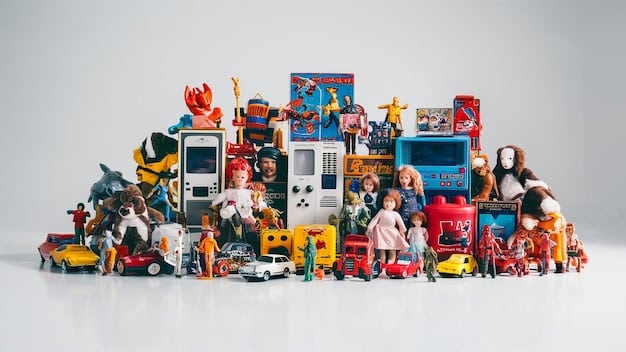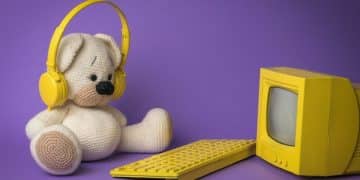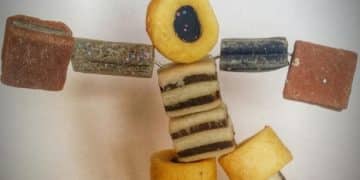Are Licensed Toys Still King? Analyzing US Market Share in 2025

In early 2025, the US toy market continues to see a significant presence of licensed toys, although independent brands and innovative play experiences are carving out increasing market share, impacting the dominance traditionally held by licensed products.
Are Licensed Toys Still King? Analyzing the US Market Share in Early 2025 reveals a captivating narrative of shifting power dynamics within the vibrant US toy market. While beloved characters and movie tie-ins maintain a strong presence, independent brands are stepping into the arena creating their own fanbases and compelling alternatives. This article explores the current landscape, examining the forces influencing consumer choices and predicting future trends.
The Enduring Allure of Licensed Toys
Licensed toys have historically reigned supreme, capitalizing on the popularity of blockbuster movies, hit TV shows, and beloved characters. This section explores the reasons behind their continued appeal.
These types of toys have a built-in fan base. Parents and kids feel something familiar with well-known characters.
Nostalgia and Brand Recognition
The influence of nostalgia cannot be overstated. Many adults purchase licensed toys based on characters they loved during their childhood, passing that love on to their children. Well-known brands benefit from instant recognition and trust.
Marketing and Media Synergy
Licensed toys are inextricably linked to large-scale marketing campaigns surrounding movies, TV shows, and video games. A new Star Wars movie equals a myriad of Star Wars-branded toys filling the shelves. This gives more visibility to the licensed brands.
- Extensive Advertising: Big-budget movies have enormous marketing budgets which also include toys.
- Cross-Promotion: Fast food chains and other companies often partner to release limited-edition toys with their products.
- Influencer Marketing: YouTube channels and other social media platforms showcase the latest licensed toys thanks to influencers.

With nostalgia, big marketing campaigns, and cross-promotion between different industries, the licensed toy market will continue their dominance.
The Rise of Independent Toy Brands
While licensed toys command significant market share, independent toy brands are making their presence known. These brands often focus on innovation, quality, and unique play experiences.
Independent Brands are finding their footing in the toy industry, with a unique approach. Quality over name recognition, that is their motto.
Focus on Innovation and Uniqueness
Independent brands often prioritize innovative designs and play concepts that set them apart from mainstream offerings. Building blocks, interactive STEM-focused kits, and artisanal hand-crafted toys offer alternatives that catch the eye of consumers wanting more than franchises.
Emphasis on Quality and Sustainability
Many independent toy companies emphasize the use of high-quality materials and sustainable manufacturing practices. Eco-friendly wooden toys, organic plush animals, and ethically sourced materials attract parents looking for environmentally conscious options.
- Direct-to-Consumer Sales (DTC): Selling directly to consumers through their own websites and online marketplaces allows independent brands to control their brand image.
- Community Building: Engaging with customers through social media and online forums fosters a sense of community.
- Niche Marketing: Concentrating on specific interests, hobbies, and values allows independent brands to connect with their core audience.
By focusing on a specific niche of sustainable and high-quality materials, independent brands are slowly finding their way into most households.
Shifting Consumer Preferences in Early 2025
Consumer preferences are constantly evolving, driven by factors such as economic conditions, technological advancements, and changing cultural values. Understanding these shifts is crucial for analyzing the toy market.
Today’s consumer isn’t just looking for a toy, they are looking for an experience and for sustainability.
The Demand for Educational Toys
Parents are increasingly seeking toys that promote learning and development. STEM-focused toys continue to surge in popularity, offering kids a fun way to explore science, technology, engineering, and mathematics. Educational toys that foster creativity, problem-solving skills, and critical thinking see increased demand.
Growing Interest in Eco-Friendly and Sustainable Toys
Consumers are more aware of the environmental impact of their purchases. Toys made from sustainable materials, such as wood, recycled plastic, or organic cotton, resonate with environmentally conscious families. Brands that show their commitment to reducing their carbon footprint will thrive.
- Digital Detox: Some parents are seeking toys that encourage unplugged play and reduce screen time.
- Inclusivity and Representation: There’s a rising demand for toys that reflect the diversity of the real world, featuring characters of different ethnicities, abilities, and genders.
- Personalization: Custom-designed toys and personalized play experiences cater to parents who want something unique for their children.

As consumers are more aware of the environmental impact and as technology evolves, the demand for toys that reflect these changes will continue.
The Impact of Technology on Toy Trends
Technology has revolutionized the toy industry, giving rise to interactive toys, augmented reality experiences, and digital play platforms. Here’s how tech influences those ever so important trends.
These days all children are drawn towards technology and the use of digital platforms. Tech and toy brands have noticed this and are creating interesting interactive toys and playgrounds.
Augmented Reality (AR) and Virtual Reality (VR) Toys
AR and VR technologies offer immersive and interactive play, engaging kids in new ways. These technologies bring physical toys to life by overlaying digital content onto the real world, or transporting children into completely virtual environments.
Interactive and Programmable Toys
Robotics kits, coding toys, and programmable building blocks empower kids to learn about technology and develop coding skills. These interactive toys foster creativity, problem-solving, and critical thinking, preparing children for the digital age.
- Mobile Gaming and Apps: Mobile games and educational apps provide children with entertaining and interactive learning experiences.
- E-commerce and Online Toy Sales: Online platforms are now the go-to location for many who search for toys.
- Social Media and Influencer Marketing: Social media platforms like YouTube, Instagram, and TikTok play a central role in shaping toy trends and influencing consumer behavior.
As digital platforms become more available and commonplace, technology and its innovations, will continue to significantly impact consumer behaviors.
Predicting the US Toy Market Share in Early 2025
Based on current trends, industry analysis, and expert projections, here’s a forecast of the US toy market share in early 2025.
The crystal ball is still a bit foggy but we can forecast the US toy market share in early 2025 with some confidence.
Licensed Toys: Maintaining a Strong Foothold
Despite the rise of independent brands and shifting consumer preferences, licensed toys are expected to maintain a substantial portion of the market share. The continued release of blockbuster movies, TV shows, and video games will keep demand high for licensed products.
Independent Brands: Gaining Ground
Independent toy brands are projected to experience continued growth, driven by their focus on innovation, quality, and unique play experiences. Parents seeking alternatives to mainstream offerings will increasingly turn to independent brands.
- Digital Influence: With digital games, social media’s and influencers, the importance of a strong plan for digital growth is highlighted.
- Economic Factors: The economy has considerable factor on consumers.
- Demographic Shifts: Different demographics prefer varied types of toys.
While it is difficult to predict with any certainty, if things continue as they are, the independent toy market is primed to expand. While licensed toys will probably still be a big player.
Strategies for Toy Companies in a Changing Market
To thrive in the evolving US toy market, companies must adapt their strategies to meet changing consumer preferences and competitive pressures.
Toy companies need to adapt to be competitive in the industry; with the shifting trends it is inevitable.
Embrace Innovation and Uniqueness
Toy companies must invest in developing innovative and unique products that cater to niche markets and consumer interests. Creating a strong brand identity and differentiating themselves from competitors.
Focus on Quality and Sustainability
Prioritizing the use of high-quality materials and sustainable manufacturing practices resonates with increasingly environmentally conscious consumers. Transparency in their supply chain will also boost companies profile.
This will make them stand out:
- Strengthen Digital Presence: Investing in digital marketing, e-commerce platforms, and social media engagement is essential for reaching today’s consumers.
- Cultivate Customer Relationships: Engaging with customers through online forums, social media, and loyalty programs fosters a sense of community and brand loyalty.
- Seek Strategic Partnerships: Collaborating with other companies, influencers, and content creators can expand reach and build brand awareness.
By focusing on community building and their company presence, especially online, toy brands may be able to thrive.
| Key Aspect | Brief Description |
|---|---|
| 🎬 Licensed Toys | Still hold substantial market share due to popularity of associated media. |
| 🌱 Independent Toys | Gaining prominence with innovative designs and sustainable practices appealing to eco-conscious consumers. |
| 📱 Technology | Augmented reality and interactive toys transform play, attracting tech-savvy children. |
| 🌍 Consumer Values | Growing consumer preference for educational, inclusive, and eco-friendly toys shape the market. |
Frequently Asked Questions
▼
Yes, licensed toys remain quite popular, leveraging the recognition and appeal of established characters from movies, TV shows, and video games.
▼
Independent brands typically focus on innovation, unique designs, high-quality materials, and sustainable manufacturing practices to stand out in the market.
▼
Technology enhances play through AR and VR toys, educational apps, and interactive games, creating more engaging and immersive experiences for children.
▼
Consumers often seek toys that are educational, promote inclusivity, are eco-friendly or sustainable, and stimulate creativity and problem-solving skills in children.
▼
Toy companies can stay competitive by embracing innovation, focusing on quality and sustainability, strengthening their digital presence, and building strong relationships with their customers.
Conclusion
The US toy market in early 2025 presents a dynamic landscape with licensed toys still holding a significant share, while independent brands emerge with innovative, sustainable offerings. Successful toy companies will be those that adapt, innovate, and align with evolving consumer preferences.





